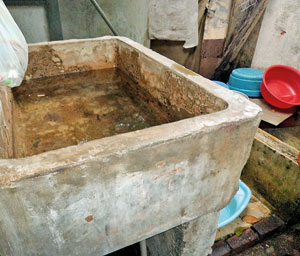News
Destroying breeding grounds vital to curb dengue: Study

Construction sites which turn into ideal mosquito breeding grounds
As the number of men, women and children hit by dengue sky-rocket, the urgent need is to keep re-visiting the potential mosquito breeding grounds and destroying them in a concerted campaign to prevent this viral disease.
This is the strong plea from the National Coordinator for the Dengue Control Programme, Dr. Hasitha Tissera who has conducted the first-ever study describing the dengue-mosquito habitats in Sri Lanka.
Schools and construction sites are the worst ‘culprits’ which are harbouring and providing a safe haven, most probably unknowingly, to the dengue mosquitoes both Aedes aegypti and Aedes albopictus, the Sunday Times learns.
Dr. Tissera comes with a scientific study in hand which categorically clears the air through the showers of rain and zeroes-in on breeding places in schools and construction sites, teeming with larvae or pupae.
The study ‘Characteristics of and factors associated with dengue vector breeding sites in the City of Colombo, Sri Lanka’ published in the Journal of Pathogens and Global Health just last month (May) deals extensively with this subject. Even the cover page of the journal is a photograph of larvae found during the study.
Conducted from April to June in 2013 at the beginning of the southwest monsoon season, in one area of the Colombo Municipal Council (CMC), it is a ‘microcosm’ look at a macro picture, says Dr. Tissera.
The highest disease incidence is found in urban areas, especially in the district of Colombo, the most densely-populated part of the country. The CMC area, within this district, with a population of 561,314 at the time of the study has a density of 14,000 people in one square kilometre. The specific ward within the CMC area which was studied has a population of 21,326 and is highly dengue-endemic.

Dr. Hasitha Tissera
Giving the background, the study states that in Sri Lanka, dengue has been legally reportable since 1996. This viral disease is emerging as a major public health problem in the country with outbreaks increasing in magnitude and frequency in the past two decades.
The aim of the study which looked at 1,469 premises was to assess Aedes mosquito breeding sites and the prevention practices of community members. The team had surveyed 1,341 residential and 128 non-residential premises. The non-residential premises comprised 11 schools, 99 work or public sites, 5 open lands and 13 which were non-specified.
In these 1,469 premises, 15,447 potential breeding sites suitable to hosting larvae or pupae were found, with 18% of these sites containing water. Of these containers with water, 16.3% were positive for larvae and/or pupae.
The findings were:
- 66.7% schools had at least one container positive for larvae and/or pupae. Schools also had the highest proportion (63.9%) of positive containers.
- 21.2% work or public sites had at least one container positive for larvae and/or pupae.
- 11.9% residential premises had at least one container positive for larvae and/or pupae.
The most common containers positive for larvae and/or pupae were:
- Discarded items – 36.1%
- Ornamental ponds – 11.5%
- Water tanks – 5.8%
- Flower-pots – 4.4%
The clear conclusion of the study is that schools and working sites were associated with the highest number of breeding sites and lacked preventive measures for vector control, said Dr. Tissera, reiterating that while pursuing vector control measures at residential level, public health strategies should be expanded in schools and workplaces.
Pointing out that vector control programmes in the country concentrate mainly on source reduction and thermal fogging, in recent years, collective approaches including environmental management of breeding sites; assessment of the influence of climatic factors (through climatic forecast data) on disease and vector; mapping for outbreak prediction; raising awareness; and improvement of case management have increasingly been employed. This is while public health education campaigns have also been conducted.
He adds that despite such measures, dengue does not appear to have abated. Therefore, it is important to assess the impact of these measures on breeding sites at community level to better target and adapt vector control strategies in the future.
Quoting the study, Dr. Tissera says that although residential premises had the highest absolute number of breeding sites, mainly because residential premises accounted for the vast majority of the surveyed premises, the proportion of containers positive for either larvae or pupae was found to be far higher in non-residential premises, particularly schools.
“More than half of the schools had at least one container positive for either larvae or pupae. This is one of the key findings of our study and has important public health implications,” he said.

An outdoor container with water – an open invitation to mosquitoes to breed here
Sending forth a strident call for more enhanced vector control measures in schools, Dr. Tissera explains that a plausible reason for the high prevalence of breeding sites in schools and public workplaces is the lack of identifiable ‘ownership’. It may be that no one is clearly assigned the responsibility for vector control at public places. The survey also showed that people operating in schools and public workplaces did not voluntarily implement vector control measures.
Community education should be targeted at addressing the importance of emptying, eliminating or covering containers which could turn into mosquito breeding places. The wide variety of potential and actual breeding containers underpins that no single intervention can be sufficient to control Aedes mosquitoes, the study has found.
The study team, in addition to Dr. Tissera, included Valérie R. Louis & Carlos Alberto Montenegro Quiñonez of the Institute of Public Health, Heidelberg University, Germany; P.A.D. Kusumawathie of the Regional Malaria Office, Kandy, of the Health Ministry, Sri Lanka; Dr. Paba Palihawadana of the Epidemiology Unit, Health Ministry, Sri Lanka; Sakunthala Janaki of the National Dengue Control Unit, Health Ministry, Sri Lanka; Yesim Tozan of the Institute of Public Health, Heidelberg University & College of Global Public Health, New York University, United States of America; Dr. Ruwan Wijemuni of the Department of Public Health, Colombo Municipal Council, Sri Lanka; and Annelies Wilder-Smith of the Institute of Public Health, Heidelberg University, Lee Kong Chian School of Medicine, Nanyang Technological University, Singapore & Department of Public Health and Clinical Medicine, Epidemiology and Global Health, Umea University, Sweden.
| Stringent checks on roof gutters in new buildings New laws to help regulate the use of roof gutters in all buildings being erected hereafter and new guidelines to ensure that existing roof gutters are free of mosquito breeding sites are crucial, stressed Dr. Hasitha Tissera, while commending the fact that the country has passed a number of laws for the prevention and control of mosquito breeding sites. In view of many plans in the coming five years for mega cities, port cities and a boom in public and private constructions, it will pose a testing time for Sri Lanka not only on the prevention of dengue but also on sustaining such prevention, he said. “This is why strict laws are essential to maintain mosquito-free environments at construction sites,” reiterated Dr. Tissera. Meanwhile, there needs to be very stringent checks all-year round for dengue mosquito breeding sites and not just when the rains come, he said, urging that the whole country must be geared to identify, predict and mitigate the threat of dengue if Sri Lanka is to win its battle against this tiny vector. Focusing on the importance for special measures to prevent dengue in “built” environments, he requests urban planners to work closely with the health authorities. With regard to schools, he points out that each and every school should appoint a specific ‘dengue’ person to go round, not just during the rains, but all throughout the year to look for mosquito breeding sites and destroy them, while construction sites also need a designated person to do so every few days. This is vital as the mosquito which spreads dengue is also a carrier of zika, chikungunya and yellow fever.
|

